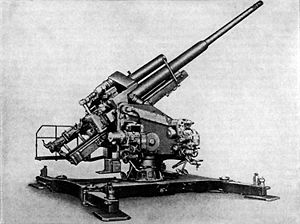12.8 cm FlaK 40
| 12.8 cm Flak 40 | |
|---|---|
 A static mounted 12.8 cm Flak 40. | |
| Type | Anti-Aircraft/Anti-Tank |
| Place of origin | Germany |
| Service history | |
| In service | 1942 to 1945 |
| Used by | Germany |
| Wars | World War II |
| Production history | |
| Designer | Rheinmetall-Borsig |
| Designed | 1936 |
| Manufacturer | Rheinmetall-Borsig |
| Produced | 1942 |
| No. built | 450 |
| Variants | 12.8 cm FlaK 40 12.8 cm FlaK 40 Zwilling 12.8 cm Panzerabwehrkanone |
| Specifications | |
| Mass | 17,000 kg |
| Barrel length | 61 calibers |
| Caliber | 128 mm |
| Breech | Horizontal sliding |
| Recoil | Hydropneumatic |
| Carriage | Static or railcar mounted. |
| Elevation | 88 degrees |
| Traverse | 360 degrees |
| Muzzle velocity | 880 m/s |
| Effective firing range | 10,675 m |
| Maximum firing range | 14,800 m |
| Feed system | Power rammer |
The 12.8 cm FlaK 40, was a German World War II anti-aircraft built as the successor to the 88 mm gun. Although it never completely replaced the 88, it was one of the most effective heavy AA guns of its era. Like the 88, it was later adapted as a pure anti-tank gun as well, although used almost entirely as a tank gun.
Development of the gun began in 1936, with the contract being awarded to Rheinmetall Borsig, the first prototype gun was delivered for testing in late 1937 and completed testing successfully. However the gun weighed nearly 12 tonnes in its firing position, with the result that its barrel had to be removed for transport. Limited service testing showed this was impractical, so in 1938 other solutions were considered.
The eventual solution was to simplify the firing platform, based on the assumption it would always be securely bolted into concrete. The total weight of the system reached 26.5 tonnes, making it practically impossible to tow cross-country. In the end this mattered little, since by the time the gun entered production in 1942 the production of mobile guns larger than 105 mm was prohibited. In August of 1944, there were 450 such cannons available. As a result only a few were built and used, amongst other places, in the anti-aircraft Flak Towers protecting Berlin. Approximately 200 were mounted on railcars, providing limited mobility.
In the anti-aircraft role the gun fired a 57.2-pound shell at 2,890 fps to a maximum ceiling of 35,000 feet. Compared with the 88, the 128 used a powder charge four times as great and which resulted in a shell flight time only one-third as long. This made aim against fast-moving targets much easier. In the anti-tank role it fired a 58.13 pound armor piercing capped projectile, capable of penetrating just over 200 mm of armor at short ranges, and 120 mm at 2,000 m range. Although its short range performance was similar to the 88, the 128 maintained its performance over much longer ranges, at 2,000 m the 88 could penetrate only 72 mm (although 88mm PaK 43 derivatives were significantly more powerful).
Variants
- 12.8 cm FlaK 40
- 12.8 cm FlaK 40 Zwilling Twin mounted anti-aircraft, capable of firing 20 rounds per minute.
- 12.8 cm Panzerabwehrkanone 44 (12.8 cm Pak 44) an anti-tank gun on a wheeled carriage. Only a small number were produced and the barrel and breech of many were reused for the Jagdtiger tank-destroyer.
External links
References
- http://www.ww2guide.com/flak.shtml#triplea
- Hogg, Ian V. (2002). Anti-aircraft artillery. Crowood Press. ISBN 1-86126-502-6.
